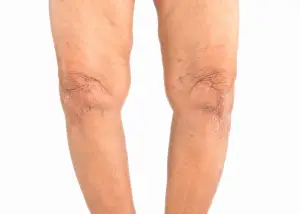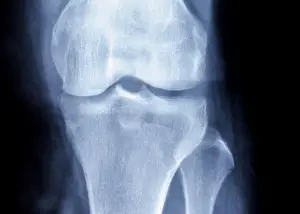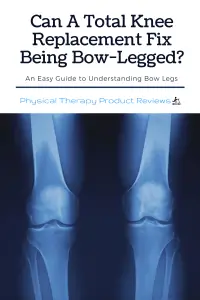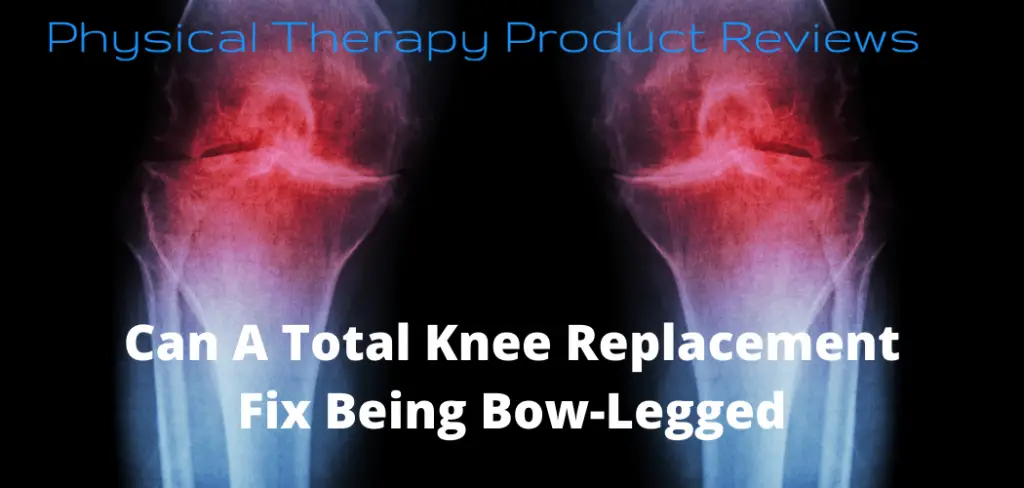One of the most common questions that bow-legged people have is whether they will be able to fix their bow-legs through a total knee replacement.
Being bow-legged affects more people than one might think and can lead to medial knee arthritis. This article reviews bow-leggedness and if a total knee replacement can fix it.
What is Bow-Legged?
Bow-leggedness can be defined as a condition where the legs bend outward, away from each other. This is different than knock knees which are legs that bow inward towards one another. Bow-legged people can have difficulty with sports and physical activities as they age and get more wear and tear on the knees.

Being Bow-legged is also called a Varus Knee Deformity. The knees bowing outward means that the pressure and weight are not evenly distributed through the joint but puts more pressure on the inside of the knee joint. This can cause an uneven wear pattern and quicker build-up of arthritis.
Why Do People Get Bow Legs?
Bow-legged people can have bow legs for a variety of reasons. One cause is an injury to one side of the knee, which causes it to bow in more than the other.
Another cause could be growth hormone deficiency or exposure to radiation that slows down bone development and weakens bones, leading to bow-legs in children and adults.
Finally, family genetics may play a large role in being bow-legged. If mom or day had a severe bow-legged posture then it can be passed on to the kids. This is the most common reason for being bow-legged. This also will progress in severity as you age and become more pronounced.
Is There any Way to Fix Bow Legs?
While being bow-legged can be corrected, it is difficult to do so. A bow-leg fix would require extensive surgery that could take up to three hours and involve muscles, tendons, and ligaments from the thigh or shin bone. This surgery is called an Osteotomy.

A knee osteotomy involves removing or adding a wedge of bone to your shinbone (tibia) or thighbone (femur) to help shift your body weight off the damaged portion of your knee joint and more evenly distribute the forces through the joint. This is typically done in younger patients before arthritis has built up in the joint.
Is Being Bow-Legged Bad?
Being bow-legged can lead to medial knee arthritis. This is when the cartilage on the inside of your knees starts wearing down and you start feeling pain in that area. This can make it difficult for bow-legged people to do everyday activities such as walking or playing sports.
However, mild varus deformity may not affect people’s functional ability in their younger years. People are still able to play sports, run, and do normal activities for most of their life with a mild bow in the legs.
Can a Total Knee Replacement Fix Being Bow-legged?
Yes, a total knee replacement can help establish normal alignment in bow-legged people.
A total knee replacement is a surgical procedure that replaces the end of your thigh bone (femur) or shinbone (tibia) with an artificial joint made of metal and plastic. A TKR uses cutting-edge technology to replicate how your natural joints work so you can walk, run and enjoy activities such as tennis.
In a bow-legged patient who has had a total knee replacement, the surgery will try and re-align the legs to make it a more normal position.
Do You Have to Have a Knee Replacement in Both Legs If you are Bow-Legged?
 If your bow-leggedness is caused by medial knee arthritis on one side of your body, then yes it might be necessary to have surgery on both knees. We typically do not recommend to have them replaced at the same time but to space it out over 6 months to allow for adequate healing.
If your bow-leggedness is caused by medial knee arthritis on one side of your body, then yes it might be necessary to have surgery on both knees. We typically do not recommend to have them replaced at the same time but to space it out over 6 months to allow for adequate healing.
However if your bow-leggedness is from family genetics or an injury that happened years ago and the bow leg has not become severe, then you may only need surgery for one knee.
It is not uncommon to have a total knee replacement on one knee and then not long after having a knee replacement on the other knee to keep things symmetrical. This does depend on how much arthritis has developed.
Will you Walk Different After a Total Knee Replacement if you are Bow-Legged?
A bow-legged person may walk differently after a total knee replacement. One leg may feel longer because they “straightened” the alignment of the knee and cause walking to feel different.
Typically for the first 6 months, most people with a total knee walk differently as other joints adjust to the knee alignment and angles of the leg. The arch of the foot may start to collapse and mild back pain is not unexpected.
Is Exercise Bad for People with Bow-Legs?
Exercise is not bad for bow-legged people. In fact, strength in the thigh and hip muscles can help protect the knee joint and prolong the life of your knee or knee replacement.
If you have bow legs, it may be a good idea to focus on strengthening your hip and thigh muscles. This will help put more of the weight on those limbs when walking or running instead of putting all pressure on the knees.
Typical exercises would include: squats, lunges, and bridges.
Exercises to Help with Bow Legs
FAQ About Being Bow-Legged
Can you ride a Bike if you Bow-legged?
Yes! Riding a bike is one of the best ways o exercise if are more bow-legged than the average person.
Riding a bike is an excellent low impact way to strengthening the legs without putting too much pressure on the knee joints themselves.
Does Stretching Help with being bow-legged?
Stretching does help some with being bow-legged however in some instances it may not be enough to make a true change.
Stretching the hamstrings, adductors, and calf muscles all can help with muscle soreness and pain with a Varus deformity.
Stretching may also delay the progression of being more bow-legged.
Can being bow-legged lead to a meniscus tear?
Being more bow-legged can lead to more wear and tear on certain aspects of the knee joint. If this wear and tear gets above the threshold of the meniscus it can cause a tear in the cartilage.
Medial meniscus tears are a common injury seen in people who are more bowlegged.
Conclusion
This article reviews bow legs and if a total knee replacement can fix bow legs. A bow leg is when one of the knees sticks out more than the other, which causes problems with the joints. The cause for bow legs could be an injury to one side of the kneecap or it could be due to family genetics that is passed down.
This article mentions how bow legs are caused, the problems bow legs cause, if there is any way to fix bowlegs, what happens after surgery for bow legs, and will you walk differently after had a total knee replacement.
Other Great Rehab Related Articles
How to Stay Active After Cervical Fractures: Expert Tips and Advice
Dealing with Painful Stairs After Ankle Replacement Surgery
Walking After a Total Ankle Replacement: Tips for a Successful Recovery
Exercises While Non-Weight Bearing After Ankle Replacement: Elevation, AROM, Leg Raises, and More
Ankle Pain with Stairs: Causes and Home Treatment Options
5 Common Mistakes You’re Making After an Ankle Sprain
Disclaimer: The information provided in this post is for educational purposes only. This is not a substitute for a medical appointment. Please refer to your physician before starting any exercise program.







